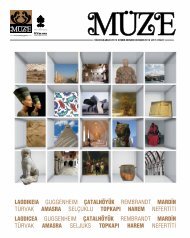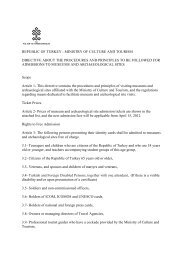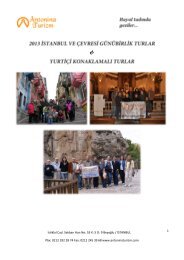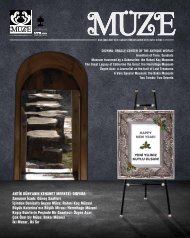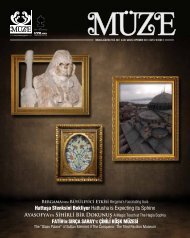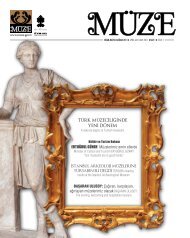GAZİANTEP ZEUGMA MOZAİK MÜZESİ
GAZİANTEP ZEUGMA MOZAİK MÜZESİ
GAZİANTEP ZEUGMA MOZAİK MÜZESİ
Create successful ePaper yourself
Turn your PDF publications into a flip-book with our unique Google optimized e-Paper software.
50<br />
SARNIÇTAKİ<br />
MEDUSA<br />
BAŞLARI<br />
Tarihi miraslar açısından etkileyici bir yelpazeye ve zenginliğe<br />
sahip olan ülkemizde, Medusa ya da Gorgon başları olarak bilinen<br />
figürlerden iki tanesi de İstanbul’da, Yerebatan Sarnıcı’nda<br />
bulunuyor. Roma Çağı’na ait iki Medusa başı, sarnıçtaki iki<br />
sütunun altında kaide olarak kullanılmış. IV. yüzyıla ait bu<br />
başların hangi yapıtlardan alındığı meçhul ama araştırmacıların<br />
tahmini, antik bir yapıdan sökülerek getirildiği ve sarnıcın inşası<br />
sırasında, sütunların kısa gelen gövdelerini yükseltmek amacıyla<br />
sütun kaidesine ihtiyaç duyulduğu için kullanıldığı yönünde. Eski<br />
Bizans’ta, kılıç kabzalarında ve sütun kaidelerinde ters ve yan<br />
olarak kullanılan Medusa başlarının kötülükleri uzak tutacağına<br />
inanılırmış. Bunun örneğini Yerebatan Sarnıcı’ndaki sütun<br />
kaidelerine biri ters diğeri ise yan olarak yerleştirilen iki Medusa<br />
başında görmek mümkün.<br />
MEDUSA HEADS<br />
AT THE SUNKEN<br />
CISTERN<br />
Two illustrious examples of the figures known as Gorgon or Medusa heads<br />
are located at the Sunken (Basilica) Cistern near the Hagia Sophia in<br />
İstanbul. Located in the northwest corner of the cistern the bases of two<br />
columns reuse blocks carved with the visage of Medusa. The origin of the<br />
two heads dated to the IVth century AD, is unknown, though it is believed<br />
that the heads were brought to the cistern after being removed from a<br />
building of the late Roman period. There is no written evidence which<br />
suggests that they were used as column pedestals previously. Tradition has<br />
it that the blocks are oriented sideways and inverted in order to negate the<br />
power of the Gorgons’ gaze. However it is also supposed that they were<br />
placed sideways and upside down only to be the proper size to support<br />
their columns. On the other hand, it is said that many Byzantium era<br />
sword handles and columns were engraved with her head upside down in<br />
connection with her believed protective power.



